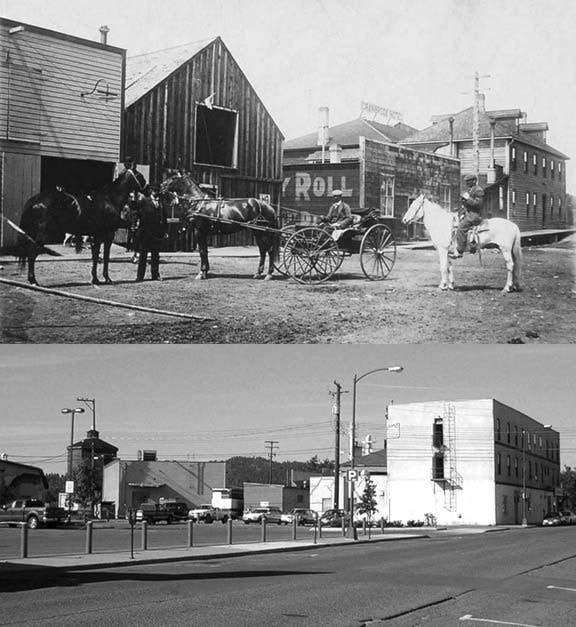Horses. You can't live with them and you can't live without them.
Well, okay, maybe now you can, but you couldn't 100 years ago. They fulfilled essentially the same function as the automobile does today: that of transportation, work, status and entertainment. Most businesses found it necessary to have at least one horse stabled out back to haul the delivery wagon. Doctors, salesmen, professionals, officials, miners, lumbermen, and workers of all stripes relied on their trusty steed. Even the railway relied on horses to move the goods upon arrival. Not everyone had a horse, of course.
Those without could always avail themselves of local liveries to rent horses, buggies, wagons and even entire pack trains if desired. The workhorse was the — well, workhorse of the community and it was upon their backs that our town was built.
Horse activity often made news over the years. Harold Pollard's horse swam across Moyie Lake in the summer of 1900, and that was considered pretty big stuff. That same month a horse feeling his oats dashed through the back gate and into the laundry room of the Cranbrook Hotel where it proceeded to destroy the stove, windows, floor and pretty much everything else before sauntering back outside.
Cranbrook city police often patrolled on horseback although the picture of Constable "Baldy" Morris riding along Baker Street, "his sylph-like form sitting so daintily upon his Arabian steed as he rode with grace and ease," may not have been entirely accurate.
The arrival of the Fire Department horse team in 1906 gave cause for much civic pride despite the $124 price tag. After all, first-class horses denoted a first-class town. A few years later, many watched with bated breath and rejoiced at his recovery when Prince, the gallant steed of the Fire Brigade, suffered from acute indigestion. A well-trained fire horse was often the difference between "little damage" and "complete destruction" and was not easily replaced.
Jake Fink, later fire chief, mayor and a man of precision, was the butt of much laughter when he narrowed the stable door behind his store on Baker Street. Following a long work day he led his horse into the stable where it ate a large meal and promptly became stuck fast on the way out. It was necessary to cut away a section of the doorframe to release the animal.
Horses could be, and often were, dangerous when spooked. Runaway horses were all too common and certainly did their part to redecorate the town. In the early years, local painters Pieper & Currie lost their store awning and sign to a runaway horse team and wagon belonging to the P. Burns Meat Company. Unabashed, they responded by saying they would paint the storefront now that it was clear.
On one occasion a hunter managed to chase down and halt a team of horses running off with his buggy. Sadly, he was clutching a revolver as he climbed in and accidentally shot and killed one of the horses.
The Robinson-MacKenzie lumber horse broke loose one spring day and headed down Baker Street where it collided with a laundry team. Knocking them asunder it continued on its way. Mr. Leitch's horse and buggy at the Cranbrook Hotel corner saw the runaway coming and sprinted towards the railway. The cart it was trailing bounced off a telegraph pole and landed on Mr. Lange's barber pole, turning both to splinters.
In the winter of 1906, Dr. Coffin (yes, that was his name), a local M.D., became the hero of Armstrong Avenue by flinging himself into a runaway sleigh, taking the reins and bringing the horse safely under control. Wilson's Jewelry fell victim to a runaway team that crashed through the large plate glass window, destroying a great deal of crystal and china in the process.
Horses running at large were a problem — not only horses, in fact, but mules, bulls, oxen, cows, sheep, goats, pigs, cattle, dogs and poultry. By 1906, the city fined owners $5.00 for impounded stallions. Other horses were $1.00, bulls $5.00, cattle $2.00, pigs $4.00 and 25 cents for each fowl. An additional $1.00 impounding fee, $1.00 a day for feeding and a possible fine of $100.00 or two months in prison made free-grazing in city limits a costly proposition.
In June, 1909, Mr. and Mrs. Beattie and their baby were returning home from a neighbourhood visit on Baker Hill when the buggy shaft broke, rendering the horses unmanageable. They started to run at high speed, hit a stump and tossed out Mr. Beattie. They eventually struck a tree whereupon Mrs. Beattie and the baby were thrown 25 feet away. Mrs. Beattie's suffered a broken collarbone and the baby numerous bruises.
In 1920, the Cranbrook Trading Co. team broke loose down the alleyway from the Cranbrook Hotel to the present day Pharmasave before colliding with a telephone pole. Loaded at the time, the wagon left a trail of flour in its wake.
It was certainly a sign of the times when, the same year, an automobile ran into the City Transfer & Warehouse rig, throwing wagon master Tom Patterson to the ground and relieving him of several teeth. The horse was suddenly the victim rather than the perpetrator.
Over the years the runaway certainly proved that a horse could move very quickly. How quickly? Well, that was a matter of conjecture and, say, how about a little bet on the side?
Next Week: The Sport of Kings.
